 License Type: Resell Rights
License Type: Resell Rights  File Size: 520 KB
File Size: 520 KB File Type: ZIP
File Type: ZIP
 SKU: 16513
SKU: 16513  Shipping: Online Download
Shipping: Online Download
Ebook Sample Content Preview:
Remember, the headline is more than a mere summary of the website. For one, it is the first thing that people see. If a headline does not instantly give an indication of not only what the page is all about but also the reasons why people should read further the moment they hit it, it will actually deter prospects.
In fact, headlines that do not communicate any benefit in reading the next paragraph or navigating the site will dissuade readers from browsing deeper, which is where most online sales are made.
So the true purpose of a headline is not to summarize or advertise the website, the salesletter, or the business behind it. It's simply to get people to read further. That's it.
In advertising parlance, a headline is the "ad for the ad." For instance, a resume is not meant to land a job but to land an interview. A headline is, in the same way, meant to land the visitor's attention and arouse their curiosity — not the sale.
If a headline does not achieve this quickly, efficiently and effectively, people will simply click away.
You may have heard of the famous "AIDA Formula," which stands for, in order: Attention, Interest, Desire, and Action. Ads must follow this formula in order to be successful. They must capture the reader's attention, arouse their interest, increase their desire and lead them to take some kind of action.
Other than "grabbers" like graphics, multimedia, or "lumpy mail" in direct mail marketing (where trinkets are added to grab people's attention), the first part of the formula often refers to the headline.
If the headline does not command enough attention (or does not command it effectively and, above all, rapidly), then the rest of the formula will fail. People will likely leave at the click of a mouse. So the headline is not meant to do anything other than increase that attention factor.
Usually, there is a gap between the prospect's problem and its solution (or a gap between where a person happens to be at the moment and the future enjoyment of a product's benefits). But many prospects either do not know there is in fact a gap or, because it is one, try to ignore it as a result.
Therefore, a headline that either communicates the presence of such a gap or implies it. Better yet, if it's one that widens it, it will likely appeal to those who can immediately relate to it. (Of course, that's people within that site's target market.)
Using a headline that immediately conveys either a problem or a potential benefit not only makes the reader aware that there is a gap but also reinforces it in the mind. (And this doesn't mean writing ALL the benefits in the headline to cover all the bases, as in the case of mega-headlines.
Some headlines are newsy, others are sensational. Either way, it doesn't matter. All that matters is that the headline gets the reader to start reading. And if you created or widen the gap mentioned earlier, then after reading the headline readers will want to know, by browsing further, how they can close that gap.
Famous sales trainer Zig Ziglar said that people buy on emotional logic. In other words, they buy on emotion but justify their decision with logic. Therefore, emotionally-charged headlines also help to widen those gaps.
The wider the gap is, the greater the desire to close it will be.
How do you achieve that? While a website should focus on the solution rather than the problem, adding a negative (or a potentially negative) situation to the headline is often more effective because it appeals to stronger emotions and motives.
Granted, this might seem somewhat unusual or contrary to what you have learned in the past. So in order to understand this, let's take a look at how human needs and emotions work.
- File Size:520 KB
- License: Resell Rights
- Category:Ebooks
- Tags:2008 Ebooks Resale Rights








